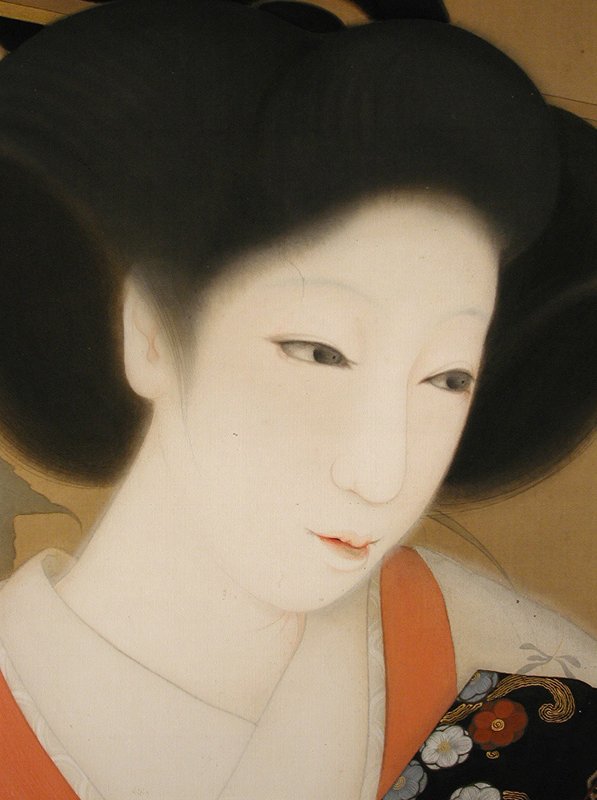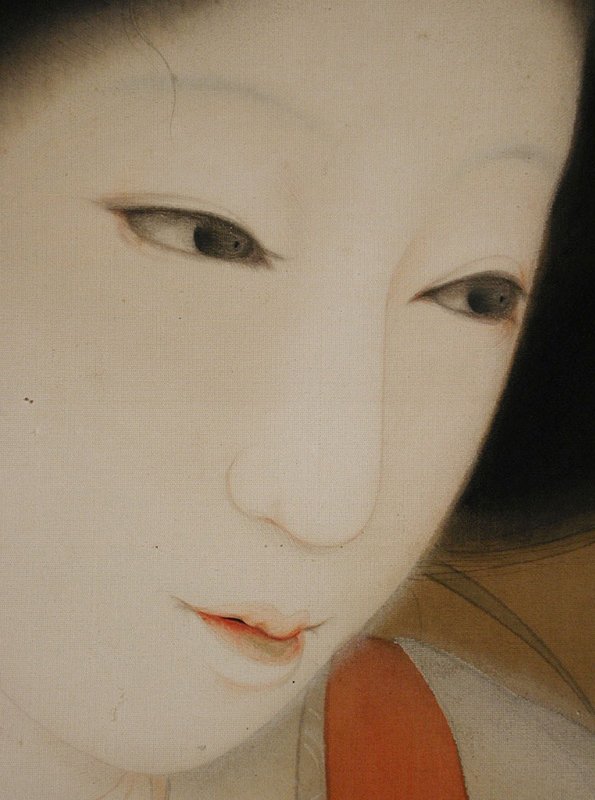PAINTINGS & SCREENS
KITANI CHIGUSA, PAINTING OF A BEAUTY CONTEMPLATING HER REFLECTION
Painting depicting a Bijin or Beauty removing a hairpin and contemplating her reflection, in sumi ink, mineral pigments, gold and gofun or clamshell gesso on silk, in the original lacquer frame. Signed by the artist on the lower left: Chigusa, and sealed (Kitani Chigusa, the go or art name of Yoshioka Eiko, 1895 – 1947). Circa Taisho 15 or 1926.
A paper label affixed to the reverse of the painting titles the work: Genroku Fujin or A Lady of the Genroku (Era), and indicates the painting’s provenance as part of the collection of Prince Kuni No Miya (from the Fushimi branch of Imperial princes, Kunihiko Kuni No Miya, born 1873, whose daughter Nagako married Hirohito, the Showa Emperor, in 1924).
Kitani Chigusa was born in Dojima in Northern Osaka. Showing an early talent for painting, she was sent at the age of 13 to Seattle for two years to study Western style painting. Returning to Japan, she moved to Tokyo when she was 18 to study Japanese style painting under Ikeda Shonen. At the age of 20 Chigusa first exhibited one of her works, at the first Daiten Exhibition (held in Koraibashi in Osaka). The same year she was invited to exhibit a painting at the 9th Bunten Art Exhibition. In 1918 she participated in the Osaka Bijutsu Tenrankai as well as showing at the 12th Bunten, and with the introduction of Takeuchi Seihobecame a pupil of Kikuchi Keigetsu. In 1920 Chigusa exhibited at the 2nd Teiten and married Kitani Hogin, bearing a son the following year. Balancing a career as a painter with her roles as wife and mother, she continued to paint and exhibit. In 1922 at the 4th Teiten and at the Hakuyosha Exhibition; in 1923 at the Nihon Bijutsu Tenrankai; in 1924 at the 5th Teiten and Osaka Bijutsu Kyokai Exhibition; in 1925 at the 6th Teiten. The same year Chigusa helped form the all-women painting group, Himawari Kai. In 1926 she was one of the founding members of another association of women painters, the Yachigusa or the Eight Plants of Autumn, and participated in the group’s first Yachigusa Kaiten Yachigusakai Exhibition. This painting was her entry at that exhibition, and can be seen in the background of a photograph of the painters taken at the opening, reprinted in Josei Nihonga-ka Kitani Chigusa: Sono Shougai to Sakuhin (Woman Nihonga Artist Kitani Chigusa: Her Life and Art), a catalogue for a 2002 retrospective of Kitani Chigusa’s work, published by the Ikeda Shiritsu Rekishi Minzoku Shiryokan, illustration Number 58, page 27. The eight classical plants of autumn used in flower arranging are called Chigusa, the art name which Kitani Chigusa had taken and then incorporated in the new association’s title, an indication of her status and reputation by then among her fellow painters. In 1927 Kitani Chigusa exhibited at the 3rd Kikuchijuku Exhibition of work by Kikuchi Keigetsu’s students, and with the Yachigusakai Shisaku Exhibition. This pattern continued through the 1930s and early 1940s, with frequent participation in the Teiten, later the Shinbunten, and among other venues the exhibitions of the Yachigusakai and the Kikuchijuku. The fire bombing of Osaka destroyed the family business in 1945, and caused the family to move several times. Kitani Chigusa died at 6:00 PM on January 24 of 1947.
Paintings of beauties are one of the classical subjects of Japanese painting. During the Late Meiji and Taisho Eras many painters became famous for their images of bijin. Partly this was because a significant audience and market existed for them, and partly in the case of women painters because the subject matter was considered appropriate. Most often though bijinga echoed the ukiyo-e tradition, and the imagery seems stylized and mask-like. Perhaps because Kitani Chigusa also studied Western painting, this depiction of a beautiful woman encompasses a psychological dimension rarely seen in the genre or prior to the 1920s.
Chigusa places her beauty in a historical context, in the Genroku Era some two hundred years earlier. She kneels in front of fusuma painted with grasses and peony blossoms, lit by a flickering candle that illuminates the gold lacquer of her hair comb and creates a soft halo about her. Kimono slightly disordered, this woman of about thirty years holds a hair pin trailing one of her hairs, both details erotically suggestive in the 1920s. One hair escapes her coiffure over her face. She holds a fabric wallet used for a small mirror, and perhaps love letters. Caught in contemplation, has she just returned from meeting her lover? A woman of her age would have been thought at the height of her beauty, on the bitter sweet edge of middle age. Chigusa’s haunting masterpiece adds a dimension to portraits of beauties beyond the traditional horizons of Japanese painting.
The famous painter and essayist Kaburaki Kiyokata published a commentary admiring this painting, Genroku Fujin, in Taisho Nihon Bijinga Zenshu.
Kitani Chigusa, Painting of a Beauty Contemplating Her Reflection
Artist Name: Kitani Chigusa
Period: Meiji Taisho
Mediums: Mineral Pigments
Form: Framed Paintings
Origin Country: Japan
51-3/4″ high x 43-1/4″ wide, dimensions of frame
This piece is no longer available.







